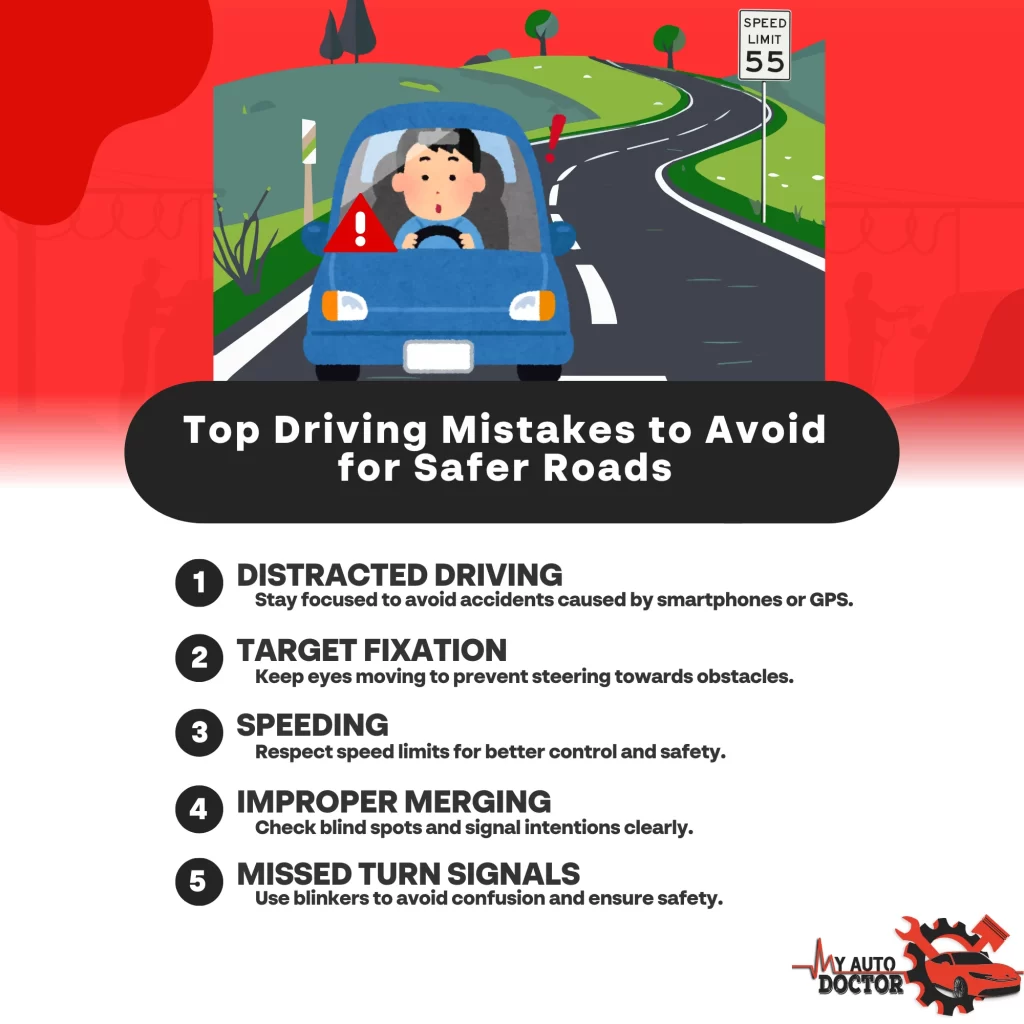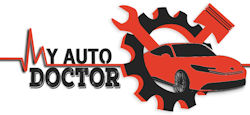The five most common driving errors you may be making include losing focus on the road, becoming victim to target fixation, exceeding speed limits, merging without checking, and not using your blinker when making turns. These mishaps contribute to a large majority of road accidents. Staying alert, scanning your surroundings, sticking to speed limits, effectively checking your blind spots and signaling appropriately are critical to avoid these common mistakes. If you’re aiming to become a safer driver, mastering these basics will offer you a robust foundation, and believe me, there’s always more to learn in the domain of safe driving!

Key Takeaways
- Distracting activities like using GPS or smartphones can lead to accidents due to lack of focus on the road.
- Target fixation, especially among novice drivers, can inadvertently lead to steering towards obstacles.
- Speeding, a common mistake, increases the risk of severe accidents and legal consequences.
- Merging without checking mirrors and blind spots can lead to serious collisions, especially on highways.
- Failing to use blinkers before turning not only creates confusion but can also result in traffic violations and fines.
Taking Your Eyes off the Road
Every driver, whether seasoned or a novice, knows the importance of keeping their eyes on the road. But, it’s easy to overlook this fundamental rule in the litany of common driving mistakes. A moment’s lapse in attention can lead to dire consequences.
One of the most common driving mistakes is taking your eyes off the road. This might occur when you’re checking your GPS, adjusting the radio, or even glancing at your smartphone. These distractions might seem harmless, but they can severely compromise your ability to react to unexpected situations.
You might think you’ve mastered the art of multitasking, but driving requires your undivided attention. Even a quick look away from the road can result in missing a pedestrian stepping onto a crosswalk, or failing to notice the brake lights of the car in front of you.
To prevent these potentially fatal mistakes, always maintain a proactive approach to driving. Keep your focus on the road, anticipate potential hazards, and refrain from distractions.
Target Fixation
In the domain of driving errors, target fixation stands as a less obvious but equally dangerous mistake. This phenomenon occurs when you focus so intently on a specific object ahead that you inadvertently steer towards it.
It’s a common driving error, especially among new drivers who are still developing their attention distribution skills.
While target fixation might seem harmless, it’s a root cause of many on-road accidents. You might fixate on a pothole, a pedestrian, or maybe another vehicle, and without realizing, you could end up heading straight towards it.
Your focus should be broad and constantly shifting, not honed in on one specific target.
To counteract target fixation, it’s crucial to keep your eyes moving and scan your surroundings. Don’t just stare at the car in front of you; instead, look far down the road.
It’s also important to stay calm and relaxed, as stress can lead to fixation.
Speeding
Speeding, a common driving mistake, can be as lethal as it’s prevalent. It’s the most common driving error and can lead to severe accidents, causing harm to you and others on the road.
Yes, it’s normal to make mistakes while driving, especially as a beginner. However, speeding is a mistake that isn’t exclusive to new drivers. Experienced motorists often fall into the trap of driving too fast, whether due to impatience, running late, or sheer disregard for the rules.
Remember, speed limits are there for a reason. They’re set based on the road conditions, traffic flow, and potential hazards, ensuring everyone’s safety. Disregarding them increases your risk of losing control of your vehicle, reduces your reaction time, and makes collisions more dangerous.
Moreover, speeding can lead to hefty fines or even license suspension. It’s not worth the risk. So, slow down, respect the speed limit, and remember that getting there safely is more important than getting there quickly.
In the end, driving cautiously and within speed limits not only makes you a safer driver but also a responsible member of the road community. Speeding is a dangerous game – don’t play it.
Merging Without Checking
Just as speeding poses a significant risk on the road, another common driving error that can result in dangerous situations is merging without checking. This most common driving error is often overlooked but can lead to severe collisions, especially on highways where traffic moves at higher speeds.
When you merge without checking, you’re making an assumption about the position and speed of other vehicles. This driver error causes the biggest problem when it leads to sudden braking or swerving by other drivers trying to avoid a collision.
Remember, not all drivers might react in time, or have the space to manoeuvre their vehicle away from yours.
Always check your mirrors and blind spots before changing lanes. Use your vehicle’s indicators to signal your intentions to other road users.
It’s also important to match your speed with the traffic in the lane you’re merging into. This allows for a smooth and safe merge, reducing the risk of accidents.
Turning Without Using Your Blinker
You might think that turning without using your blinker is no big deal, but it’s a driving mistake that can cause serious accidents. Unfortunately, most drivers make driving errors like this without even realizing it. Blinkers aren’t just decorative lights on your car – they’re vital safety signals that communicate your intentions to other drivers.
The most common driving error is neglecting to signal before making a turn. This can create confusion, frustration, and dangerous situations on the road. If drivers aren’t aware of your plan to turn, they can’t adjust their driving to accommodate your move. It’s a simple courtesy that also has significant safety implications.
Using your blinker isn’t just a good idea – it’s the law. Failing to signal can result in a traffic violation in many jurisdictions. This could lead to fines, points on your license, or even an accident if another driver can’t anticipate your move.
Frequently Asked Questions
What Are the Consequences of Not Maintaining an Appropriate Following Distance?
Not maintaining an appropriate following distance can lead to rear-end collisions. You won’t have enough time to stop if the car in front brakes suddenly. This mistake can cause injuries and costly vehicle damage.
Why Is It Important to Regularly Check Tire Pressure and Tread?
You’ve got to regularly check your tire pressure and tread. It’s essential for your safety, ensuring ideal vehicle performance, and fuel efficiency. Neglecting it can lead to poor handling, tire blowouts, or even accidents.
How Does Distracted Driving Affect Brake Response Time?
When you’re distracted while driving, your brake response time slows. You’re not fully aware of your surroundings, so it takes longer to react to sudden changes. This could lead to accidents, so stay focused.
What Are the Common Signs of Brake Failure While Driving?
You’re often first alerted to brake failure by noises like grinding or squealing. You may also feel a spongy brake pedal, notice your car pulling to one side, or see a warning light on your dashboard.
Why Is It Crucial to Adapt Driving to Weather Conditions?
Adapting your driving to weather conditions is essential. Poor weather can considerably reduce visibility and road grip, increasing accident risk. You’ve to drive slower, maintain greater distance, and use appropriate lights for safety.
Conclusion
You might think you’re a pro behind the wheel, but even the best can slip up. Don’t fall victim to common mistakes like distracted driving, target fixation, and speeding. Double-check your blind spots before merging and always use your turn signals. You might argue that these errors are insignificant, but they’re not. Each one can lead to dangerous situations. So, let’s drive mindfully, enhancing our skills for a safer road experience for all.
